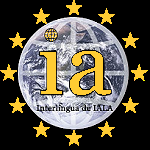
Interlingua

Interlingua (/ɪntərˈlɪŋɡwə/; ISO 639 language codes ia, ina) is an Italic international auxiliary language (IAL), developed between 1937 and 1951 by the International Auxiliary Language Association (IALA). It ranks among the top most widely used IALs (along with Esperanto and Ido), and is the most widely used naturalistic IAL: in other words, its vocabulary, grammar and other characteristics are derived from natural languages, rather than being centrally planned. Interlingua was developed to combine a simple, mostly regular grammar with a vocabulary common to the widest possible range of western European languages, making it unusually easy to learn, at least for those whose native languages were sources of Interlingua's vocabulary and grammar. Conversely, it is used as a rapid introduction to many natural languages. Interlingua literature maintains that (written) Interlingua is comprehensible to the hundreds of millions of people who speak Romance languages, though it is actively spoken by only a few hundred. The name Interlingua comes from the Latin words inter, meaning 'between', and lingua, meaning 'tongue' or 'language'. These morphemes are identical in Interlingua. Thus, 'Interlingua' would mean 'between language'. The expansive movements of science, technology, trade, diplomacy, and the arts, combined with the historical dominance of the Greek and Latin languages have resulted in a large common vocabulary among European languages. With Interlingua, an objective procedure is used to extract and standardize the most widespread word or words for a concept found in a set of control languages: English, French, Italian, Spanish and Portuguese, with German and Russian as secondary references. Words from any language are eligible for inclusion, so long as their internationality is shown by their presence in these control languages. Hence, Interlingua includes such diverse word forms as Japanese geisha and samurai, Arabic califa, Guugu Yimithirr gangurru (Interlingua: kanguru), and Finnish sauna. Interlingua combines this pre-existing vocabulary with a minimal grammar based on the control languages. People with a good knowledge of a Romance language, or a smattering of a Romance language plus a good knowledge of the international scientific vocabulary can frequently understand it immediately on reading or hearing it. The immediate comprehension of Interlingua, in turn, makes it unusually easy to learn. Speakers of other languages can also learn to speak and write Interlingua in a short time, thanks to its simple grammar and regular word formation using a small number of roots and affixes. Once learned, Interlingua can be used to learn other related languages quickly and easily, and in some studies, even to understand them immediately. Research with Swedish students has shown that, after learning Interlingua, they can translate elementary texts from Italian, Portuguese, and Spanish. In one 1974 study, an Interlingua class translated a Spanish text that students who had taken 150 hours of Spanish found too difficult to understand. Gopsill has suggested that Interlingua's freedom from irregularities allowed the students to grasp the mechanisms of language quickly. The American heiress Alice Vanderbilt Morris (1874–1950) became interested in linguistics and the international auxiliary language movement in the early 1920s, and in 1924, Morris and her husband, Dave Hennen Morris, established the non-profit International Auxiliary Language Association (IALA) in New York City. Their aim was to place the study of IALs on a scientific basis. Morris developed the research program of IALA in consultation with Edward Sapir, William Edward Collinson, and Otto Jespersen. The IALA became a major supporter of mainstream American linguistics, funding, for example, numerous studies by Sapir, Collinson, and Morris Swadesh in the 1930s and 1940s. Alice Morris edited several of these studies and provided much of IALA's financial support. IALA also received support from such prestigious groups as the Carnegie Corporation, the Ford Foundation, the Research Corporation, and the Rockefeller Foundation.
